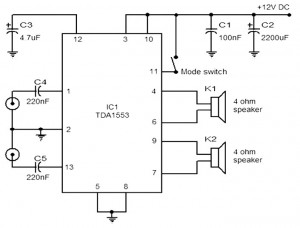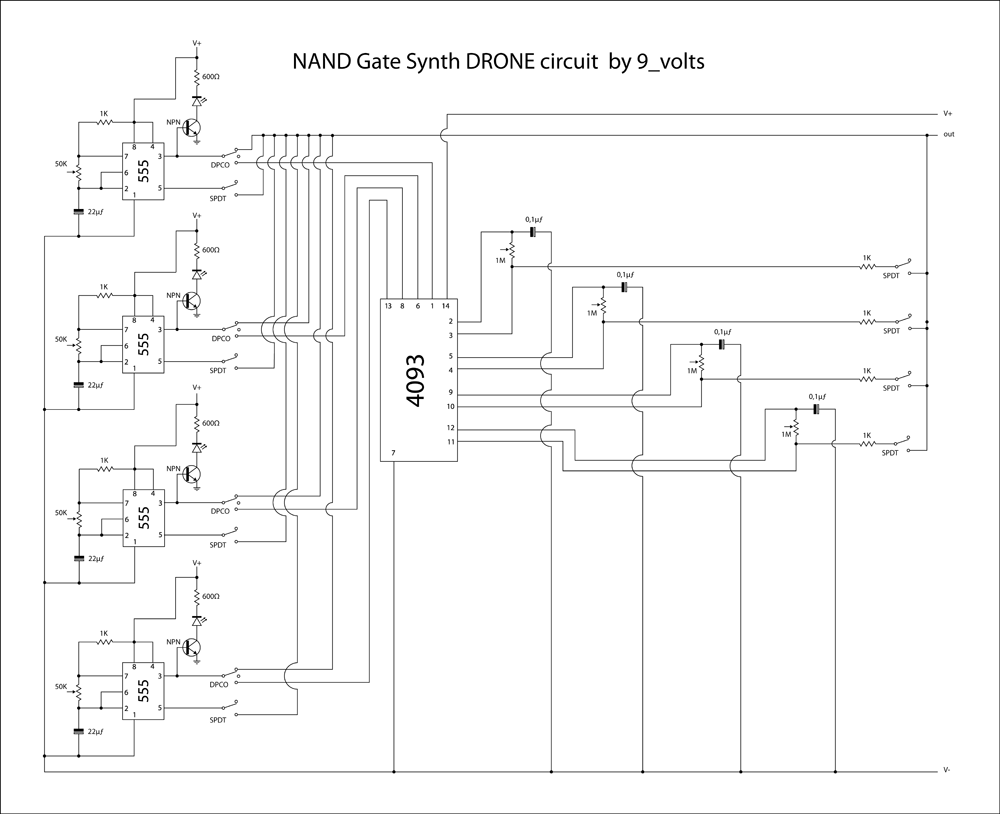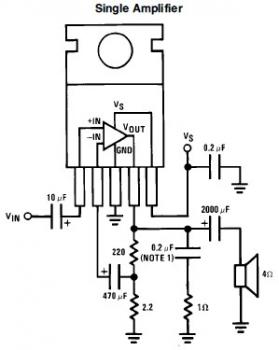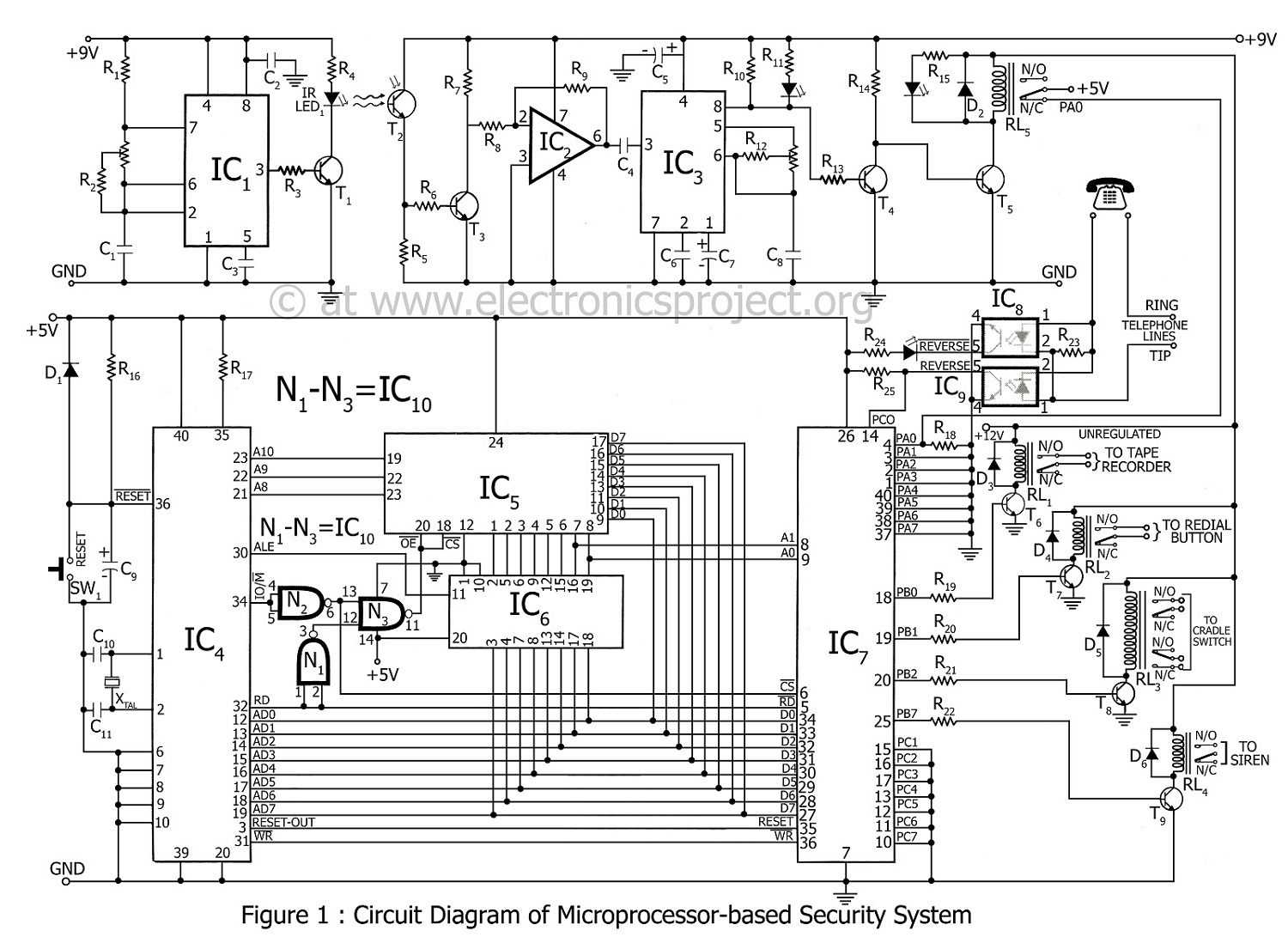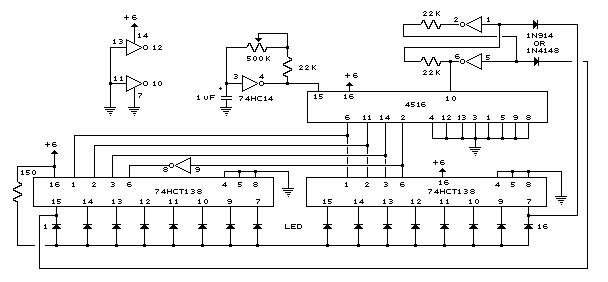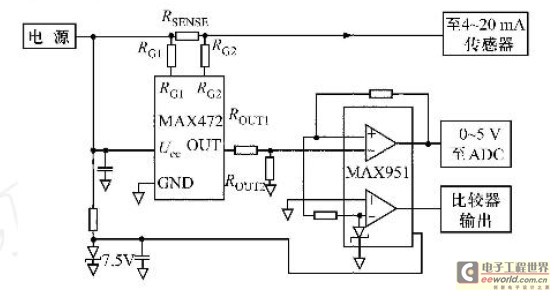
4017 based sequencer
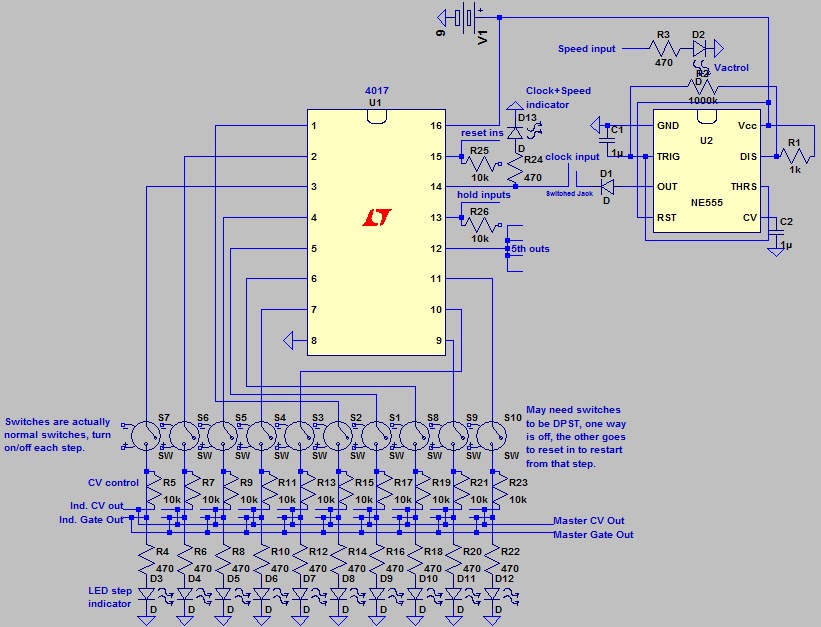
Below is the clock section. The knob controls the speed of the internal oscillator, which can be voltage-controlled via the Speed In input. Alternatively, a user-defined clock signal can be inserted via the Clock In. This feature is somewhat unconventional, but it is considered beneficial. Following this, there are 10 steps, each equipped with a CV control (+9V to 0V), an LED step indicator, and individual CV and Gate outputs. A three-way switch is also present, allowing each step to be turned on or off, or set to reset the sequence. This enables the creation of a 1-step sequence or the ability to configure the 9th step to reset, resulting in a standard 8-step sequencer. Additionally, there are Hold and Reset inputs. The Hold input maintains a step indefinitely when receiving a high gate signal, while the Reset input returns the sequence to step 1. Both inputs can be controlled by any source generating a high gate signal, including a +9V CV signal. Each input also features an attenuated input for additional control. The Master CV and Gate outputs function similarly to the individual CV and Gate outputs, but they aggregate the outputs from each step. This allows for patching the master CV to an oscillator to sequence pitch. The design prioritizes maximum patchability, acknowledging that some components may not be utilized, but their potential usefulness is evident for those familiar with contemporary sequencer operation. The schematic may not be entirely accurate due to limitations in the LTSpice components used, but it provides sufficient information for construction. Attention must be paid to the specific 4017 variant and its outputs to ensure proper functionality. It is also recommended to connect the third setting of the three-way switch to the reset pin for intended operation. Alternatively, a step's gate output can be patched to the reset input using a standard on/off switch. Insights gained from this project include the understanding that the speed of the 555 timer is influenced not only by the resistor but also by the capacitor between pins 1 and 2. The shunting capacitor, primarily for precision, can vary in size (typically between 1uF and 10nF). Using a 1uF capacitor, as in this circuit, allows for a frequency range of 0.5Hz to 1500Hz. The previously utilized oscillator, which employed 10nF capacitors, was limited to frequencies in the hundreds of Hz, falling outside the audio range, which is not ideal for a synthesizer's primary sound source. This newfound understanding may facilitate the design of an LFO module by integrating the clock circuit from this design, incorporating the oscillator's waveshaping section, adding voltage control, resulting in a straightforward LFO module. Further curiosity remains regarding the methods employed by Pittsburgh Modular to achieve an extensive frequency range with their oscillator. Note that pictures of the modular system are not available, as the necessary components and skills to construct these modules are currently lacking.
The clock section of the circuit serves as the foundation for timing and sequencing operations. The internal oscillator's speed is adjustable through a knob, with the added functionality of voltage control via the Speed In input, allowing for dynamic modulation of the oscillator frequency. The Clock In input enables the integration of external clock signals, providing flexibility for synchronization with other devices or sequencers.
The sequencer consists of 10 discrete steps, each featuring a control voltage (CV) input that ranges from +9V to 0V, allowing for precise control over pitch and other parameters. Each step is equipped with an LED indicator, providing visual feedback on the active step. The individual CV and Gate outputs enable connection to various modules, facilitating complex signal routing and modulation.
The three-way switch is a critical component, offering multiple operational modes for each step. Users can choose to activate or deactivate a step or configure a step to act as a reset point, enhancing the sequencer's versatility. This design choice allows for creative sequencing possibilities, including the option to create single-step sequences or reset configurations.
Hold and Reset inputs are integral for performance and control. The Hold input allows a step to be sustained indefinitely when receiving a high gate signal, enabling the creation of sustained notes or effects. The Reset input returns the sequence to its initial state, providing a straightforward means to restart the sequence. Both inputs are designed to accept high gate signals from various sources, ensuring compatibility with a wide range of control voltages.
The Master CV and Gate outputs aggregate the outputs from all steps, allowing for centralized control of pitch and gate signals. This design enhances patchability, enabling users to connect the master outputs to external modules, such as oscillators, for synchronized performance.
Overall, the schematic design emphasizes flexibility and user control, making it suitable for a variety of musical applications. The insights gained from the design process, particularly regarding the 555 timer's operation and capacitor selection, contribute to a deeper understanding of oscillator behavior and potential applications in modular synthesis. The design encourages experimentation and adaptation, inviting users to explore the full capabilities of the sequencer within their modular systems.Below that is the clock section. The knob controls the internal oscillator`s speed, and that can be voltage-controlled via the `Speed In` input. Or, you can insert your own clock signal via the `Clock In`. This is slightly unusual, but I think having the option is useful. -Then you get to the 10 steps. Each has a CV control (+9V to 0V), LED step i ndicator, and individual CV and Gate outputs. You`ll also note the three-way switch. This can turn on or off each step, or can set that step to reset the sequence (so you can literally have a 1-step sequence if you want, or you can switch the 9th step to reset and have a musically normal 8-step sequencer) -After that you have Hold and Reset inputs. Hold will holda step indefinitely given a high gate signal. Reset will reset the sequence to step 1. Either can be controlled with anything that can create a high gate signal, even a +9V CV signal. Each also has an attenuated input, should you need it. -Master CV and Gate are just like the individual CV and Gate, but each step outputs to it. This way you can, say, patch the master CV to an oscillator and sequence the pitch. You may ask why I did what I did here, and it`s mainly for maximum patchability. It`s totally possible you`d never use parts of it, but I`m sure you can see the usefulness of each part (assuming you know how most sequencers work nowadays) This schematic isn`t entirely accurate, mainly because my version of LTSpice doesn`t have some of the parts.
Given the description you can build it, though. You`ll have to pay attention to your exact 4017 and its outputs, otherwise this schematic will be a bit wonky for you. Oh, and of course, you`ll want to connect your 3-way switch`s 3rd setting to your reset pin if you want that.
You could also just patch a step`s gate output to the reset input and use a normal on/off switch. I actually learned something useful with this project (as I usually do): the 555 timer`s speed is controlled not only by the resistor, but the capacitor between pins 1 and 2. The shunting cap is only for precision and can be just about any size (at least, between 1uF and 10nF).
Using a 1uF cap, like in this circuit, you can get a frequency range of. 5Hz to 1500Hz. With my normal oscillator (which will probably be changed now) used 10nF caps, and bottomed out in the hundreds Hz range and went out of the audio range. That`s kinda useless given that it`s the main source of sound in a synthesizer. Also, given this new knowledge, I think I know how to create an LFO module: just use the clock circuit from this, usemy oscillator`s waveshaping section, add voltage control, and bam!
» Instant LFO module. Though I do wish I knew how Pittsburgh Modular got such an insane frequency range with their Oscillator. Oh, and for those of you looking for pics of my modular, well, it doesn`t exist. I don`t have all the parts or skills to actually build these as modules. Given a number of pots, jacks, and the ability to work sheet metal, then I`ll start building them. 🔗 External reference
The clock section of the circuit serves as the foundation for timing and sequencing operations. The internal oscillator's speed is adjustable through a knob, with the added functionality of voltage control via the Speed In input, allowing for dynamic modulation of the oscillator frequency. The Clock In input enables the integration of external clock signals, providing flexibility for synchronization with other devices or sequencers.
The sequencer consists of 10 discrete steps, each featuring a control voltage (CV) input that ranges from +9V to 0V, allowing for precise control over pitch and other parameters. Each step is equipped with an LED indicator, providing visual feedback on the active step. The individual CV and Gate outputs enable connection to various modules, facilitating complex signal routing and modulation.
The three-way switch is a critical component, offering multiple operational modes for each step. Users can choose to activate or deactivate a step or configure a step to act as a reset point, enhancing the sequencer's versatility. This design choice allows for creative sequencing possibilities, including the option to create single-step sequences or reset configurations.
Hold and Reset inputs are integral for performance and control. The Hold input allows a step to be sustained indefinitely when receiving a high gate signal, enabling the creation of sustained notes or effects. The Reset input returns the sequence to its initial state, providing a straightforward means to restart the sequence. Both inputs are designed to accept high gate signals from various sources, ensuring compatibility with a wide range of control voltages.
The Master CV and Gate outputs aggregate the outputs from all steps, allowing for centralized control of pitch and gate signals. This design enhances patchability, enabling users to connect the master outputs to external modules, such as oscillators, for synchronized performance.
Overall, the schematic design emphasizes flexibility and user control, making it suitable for a variety of musical applications. The insights gained from the design process, particularly regarding the 555 timer's operation and capacitor selection, contribute to a deeper understanding of oscillator behavior and potential applications in modular synthesis. The design encourages experimentation and adaptation, inviting users to explore the full capabilities of the sequencer within their modular systems.Below that is the clock section. The knob controls the internal oscillator`s speed, and that can be voltage-controlled via the `Speed In` input. Or, you can insert your own clock signal via the `Clock In`. This is slightly unusual, but I think having the option is useful. -Then you get to the 10 steps. Each has a CV control (+9V to 0V), LED step i ndicator, and individual CV and Gate outputs. You`ll also note the three-way switch. This can turn on or off each step, or can set that step to reset the sequence (so you can literally have a 1-step sequence if you want, or you can switch the 9th step to reset and have a musically normal 8-step sequencer) -After that you have Hold and Reset inputs. Hold will holda step indefinitely given a high gate signal. Reset will reset the sequence to step 1. Either can be controlled with anything that can create a high gate signal, even a +9V CV signal. Each also has an attenuated input, should you need it. -Master CV and Gate are just like the individual CV and Gate, but each step outputs to it. This way you can, say, patch the master CV to an oscillator and sequence the pitch. You may ask why I did what I did here, and it`s mainly for maximum patchability. It`s totally possible you`d never use parts of it, but I`m sure you can see the usefulness of each part (assuming you know how most sequencers work nowadays) This schematic isn`t entirely accurate, mainly because my version of LTSpice doesn`t have some of the parts.
Given the description you can build it, though. You`ll have to pay attention to your exact 4017 and its outputs, otherwise this schematic will be a bit wonky for you. Oh, and of course, you`ll want to connect your 3-way switch`s 3rd setting to your reset pin if you want that.
You could also just patch a step`s gate output to the reset input and use a normal on/off switch. I actually learned something useful with this project (as I usually do): the 555 timer`s speed is controlled not only by the resistor, but the capacitor between pins 1 and 2. The shunting cap is only for precision and can be just about any size (at least, between 1uF and 10nF).
Using a 1uF cap, like in this circuit, you can get a frequency range of. 5Hz to 1500Hz. With my normal oscillator (which will probably be changed now) used 10nF caps, and bottomed out in the hundreds Hz range and went out of the audio range. That`s kinda useless given that it`s the main source of sound in a synthesizer. Also, given this new knowledge, I think I know how to create an LFO module: just use the clock circuit from this, usemy oscillator`s waveshaping section, add voltage control, and bam!
» Instant LFO module. Though I do wish I knew how Pittsburgh Modular got such an insane frequency range with their Oscillator. Oh, and for those of you looking for pics of my modular, well, it doesn`t exist. I don`t have all the parts or skills to actually build these as modules. Given a number of pots, jacks, and the ability to work sheet metal, then I`ll start building them. 🔗 External reference
